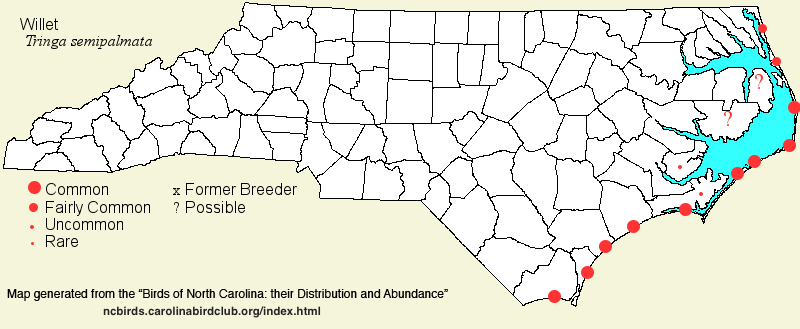 |  |
|
Willet - Tringa semipalmata SCOLOPACIDAE Members: | Search Common: Search Scientific: |
|
|
|||||||
| General Comments | The Willet is one of the few shorebirds that nests in North Carolina, and essentially the only one that nests within salt marshes, as opposed to open sand flats and other exposed locations. It is very noisy, large, and conspicuous, especially noisy when defending its nest as it makes passing flights at human intruders. Though other shorebirds and terns that nest along our coast are declining, Willet numbers seem to be holding their own, but admittedly, few surveys have been done to census the nesting population; and because they nest in marshes, mostly singly, a complete statewide survey would be difficult. Willets are essentially a coastal species in North Carolina, feeding along the ocean beach, as well as at other tidal waters and mudflats, and also in fresh and brackish pools and ponds. This species also nests in the interior of the continent, and this subspecies (inornata) has been considered by some scientists to merit elevation to full species status, based on various physical and behavioral characters. It is likely that this interior subspecies -- the "Western" Willet -- is the primary one seen on inland mudflats during migration. This interior subspecies departs its breeding grounds in fall for coastal areas, and is known to winter along the Atlantic coast; in fact, it is apparently the only subspecies along the North Carolina coast in winter. The "Eastern" Willet is thought to essentially depart NC in fall, and it winters south of the United States. Birders should familiarize themselves with both subspecies, especially if the interior subspecies is given full species status some day; in such a case, that species would be named the Western Willet and the coastal one presumably the Eastern Willet. (A split, if it happens, would or could create havoc with the identification of any and all interior reports; "Willet sp." would be a very unsatisfactory way to record the inland reports!) | ||||||
| Breeding Status | Breeder | ||||||
| NC BRC List | Definitive | ||||||
| State Status | |||||||
| U.S. Status | |||||||
| State Rank | S4B,S4N | ||||||
| Global Rank | G5 | ||||||
| Coastal Plain | Permanent resident, with migratory movements, along the coast, breeding in salt and brackish marshes. Common along the coast most of the year, but only fairly common along the northern half in midwinter. In the Tidewater zone, breeding uncertain; mostly uncommon all year, and found mainly in tidal water areas, though it does occur at times in fresh water. Farther inland, a very rare to rare migrant, primarily at reservoirs; mainly early May to mid-Jun, and early Aug to mid-Sep; some of the fall records are following hurricanes and other storms and might relate to Atlantic coast birds (subspecies semipalmata) being carried inland. Peak counts: 490, Oregon Inlet, 29 Sep 1991; 480, Bodie-Pea Is. CBC, 29 Dec 1994. | ||||||
| Piedmont | Transient. Very rare in spring, and rare in fall; quite erratic, and many records in fall are of storm-displaced birds (suggesting that most migrants pass over the province for coastal regions unless forced down by bad weather). Mainly late Apr to mid-May, and early Jul to early Sep (with most records in late Jul and Aug). Two at Falls Lake (Durham) on 10 Jun 2017 were most unusual for that month, as was one at Lake Brandt (Guilford) from 20-26 Jun 2023 and another at Jordan Lake (Chatham) on 18 Jun 2025. Peak counts: 14, Falls Lake, 21 Aug 1996; 11, Jordan Lake, 5 May 2002; 9, Lake James SP, 13 May 2013. | ||||||
| Mountains | Transient, nearly all records at low elevations in the southern mountains. Very rare in spring, with about 18 records: 1, Lake Junaluska (Haywood), 26 Apr 2004 (photograph); 1, Hooper Lane (Henderson), 28-30 Apr 2006; 1, Pisgah Forest (Transylvania), 9 May 2008; 1, Lake Junaluska (Haywood), 8 May 2011; 7 at the water treatment plant (Henderson), 26 Apr 2012; a surprising 18 at Lake Julian (Buncombe) on 25 Apr 2015, with 12 remaining to 1 May 2015; an excellent 15 video-recorded along the French Broad River at Hot Springs (Madison), 28 Apr 2016; and 9 along Wilson Road near Brevard (Transylvania) on 16 May 2018. There were four records in spring 2020, including the first for the northern half of the mountains -- 5 along the Watauga River (Watauga) on 26 Apr. Two records in spring 2021 were 3 at Lake Junaluska on 30 Apr, and one at Nantahala Lake (Macon) on 30 Apr. In spring 2025, there was a remarkable flurry of records, mostly owing to bad weather: 16-17 at a water treatment plant (Henderson) on 25 Apr; 15 were at Lake Junaluska on 26 Apr; 5 were at Lake Emory (Macon) on 15 Apr; and one was at Ecusta Pond (Transylvania) on 13 May. Also very rare in "fall", with only about 11 records: five records in Jul, five in Aug, and one on 9 Sep 2004 (associated with Tropical Storm Frances). Peak counts: 30, Lake Junaluska, 23 Apr 2020; 18, Lake Julian, 25 Apr 2015; 16-17, Henderson, 25 Apr 2025; 15, Hot Springs, 28 Apr 2016; 15, Lake Junaluska, 26 Apr 2025. | ||||||
| Finding Tips |
Willets are noisy and hard to miss along the coast for most of the year. **** | ||||||
| Attribution | LeGrand[2025-10-21], LeGrand[2025-10-20], LeGrand[2025-07-24] | ||||||
| NC Map Map depicts all counties with a report (transient or resident) for the species. | Click on county for list of all known species. |
| NC Breeding Season Map Map depicts assumed breeding season abundance for the species. |  |